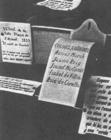<< | Índex? | >>
Blaverism and Falles
To speak simply of the final stage of Francoism and the Spanish Transition, these evidences shall demonstrate the close connection between the birth of anti-Catalanism in the Valencian Country and the world of the Falles (the Falles are a typical Valencian festivity that takes place on March every year, in which wooden satirical statues are burned. Its origins can be traced in pagan festivities that were christianized and that celebrate the transition between winter and spring):
- In 1963 the falles Cádiz-Literato Azorín, Peu de la Creu-D. Joan de Vilarrasa and Plaça de la Mercè, publicly insulted Joan Fuster for his works Nosaltres els valencians (We, the Valencians) and El País Valenciano (the Valencian Country).
- In 1966 a publisher of the magazine Fonorama had to flee València because he wrote against the prevailing orthodoxy in Falles.
- In 1968, the then president of the Junta Central Fallera (entity that rules the Falles), after calling the Falleros concentrated for the Crida act "borregos" (sheep), stopped his sure dismissal through the rapid support, obtained by his faithful men, of 165 Falla commissions.
- In 1974 the Junta Central Fallera suppressed the III Corretgeria-Bany dels Pavesos Theater Contest, for being "Catalanist" and "unofficial".
- In 1976 the Junta Central Fallera mobilized the Falles masses against the allegedly "anti-Fallero" content of the anarchist magazine Ajoblanco.

Subtle anti-Catalanism in the explanatory signs of the Falles
- In 1978 the Junta Central Fallera suppresses the 1953 banner (the four-barred ensign) and replaces it with another one that reproduces the blue-striped flag of the city of València.
- At the end of the 1970s, the Junta Central Fallera destroys the alternative experiment of the King-Kong Falla and during the first half of the 1980s, the popular and progressive examples of Cambrils-Camí de Montcada and, above all, Jacomart-Camí de Montcada.
- The Falles Regulation of 1980 recognizes all the symbols of identity defended by Blaverism, which were not exactly the ones raised by the anti-Francoist democratic forces.
- In 1982 the regionalist right, when the denomination "Reino de Valencia" was rejected in the Congress of Deputies for the Valencian Statute of Autonomy, organized-specifically the Regne de València-Duc de Calàbria commission and Vicente González Lizondo as visible leader-a protest, using the Falles commissions (no more than 100 supported the protest) to burn the scaffolds at 3 A.M.
- In the VII Fallero Congress (1988-1990) the majority of the Falles world approves the amendment that Valencian must be written according to the orthographic norms of the Academia de Cultura Valenciana, in clear opposition to the Norms of Castelló and to the University, defended by the most progressive sectors of Valencian society.
And more could be added. Much more, especially since 1991, the year in which the Blaverist regionalists got the control of the Junta Central Fallera.

 © 2004-2011 Antiblavers.org i altres contribuïdors |
visites
© 2004-2011 Antiblavers.org i altres contribuïdors |
visites